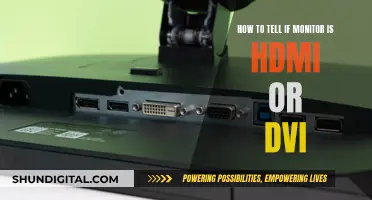
When it comes to monitor mounts, the screws used are typically M4, M5, M6, or M8, with M6 being the most common size. These metric screws are often used for mounting LCD monitors to stands, VESA mounts, or arcade cabinets. It's important to use the correct screw size to avoid damaging the monitor. The right screws will fit into the monitor without the need for a washer or stand-off. The manual for your monitor may specify the required screw size, and it's recommended to refer to the VESA mount standard for screw length and thread pitch.
| Characteristics | Values |
|---|---|
| Types of Monitor Mounts | Desk mounts, wall mounts, ceiling mounts |
| Types of Screws | VESA screws, non-VESA screws |
| Thread Sizes | M4, M5, M6 |
| Arcade Cabinet Mounting Screws | M6-20, M6-25 |
| Screw Lengths | M4 x 10mm, M5 x 12mm, M6 x 12mm, M6 x 20mm, M6 x 25mm |
What You'll Learn

VESA screws are standardised and commonly used in monitor mounts
The VESA standard defines the distance between the mounting holes on the back of a TV or monitor, and it's important to understand how the standard works before purchasing a mount. The VESA size of your TV or monitor can typically be found in the user manual or on the manufacturer's website. If not, you can measure the horizontal and vertical distances between the centres of the mounting holes to determine the VESA size.
When it comes to the VESA screw size, it will depend on the VESA size of your television or monitor. M4 screws are typically used for smaller sizes (under 200 mm), while M6 screws are commonly chosen for 200x200 screens. For even larger screens, M8 screws are usually required. It's worth noting that most monitors are mounted using metric M6 screws, and this standard is followed by manufacturers such as Dell, LG, Sony, ViewSonic, BenQ, IBM, Asus, Acer, and MSI.
You can find universal VESA mounting hardware kits readily available online, which include various screw sizes (M4, M5, M6, M8) and spacers to fit most TV and monitor mounts. These kits ensure you have the correct screws and avoid potential damage to your equipment from using the wrong size.
Monitor Size Standards: What's the Average?
You may want to see also

Non-VESA screws are not standardised and may require custom mounts
When it comes to monitor mounts, selecting the right screw size is crucial. The VESA Mounting Standard, maintained by the Video Electronics Standards Association (VESA), is a set of regulations that most brands follow. It dictates the placement of the hole pattern on the back of displays and specifies the screws used. The standard provides measurements for screw length, diameter, and pitch to ensure a secure fit for flat-screen televisions and monitors.
However, not all screws adhere to the VESA standard. Some monitors may have non-standard VESA mount screw sizes, and it is important to verify the size before purchasing a mount. Non-VESA screws are not standardised, and this lack of standardisation may require the use of custom mounts. The screws that attach a monitor's stand, for instance, are typically non-standard and designed specifically for that purpose.
In some cases, monitors may have no VESA mount screw holes at all. It is crucial to check the specifications of your monitor before purchasing a mount to ensure compatibility. If your monitor does not have mounting holes, you may need to purchase an adapter or a VESA-compatible bracket.
When dealing with non-VESA screws, it is essential to exercise caution. Using the wrong screw size can lead to instability and even damage to your monitor. If you are unsure about the size or type of screw required, it is recommended to consult a professional or contact the manufacturer for guidance.
To summarise, while the VESA standard provides guidelines for screw sizes, non-VESA screws vary and may necessitate custom mounting solutions. Always verify screw sizes and compatibility before proceeding with any monitor mounting project to avoid potential issues.
Monitor Size Options for the Surface Pro Explained
You may want to see also

Thread size refers to the diameter of the screw
When it comes to monitor mount screws, it's essential to understand the concept of thread size. Thread size specifically refers to the diameter of the screw, and this measurement is crucial for ensuring a secure and compatible fit between the screw and the corresponding hole.
The thread size of a screw is denoted by a letter and a number. The letter "
It's important to select the correct thread size for your monitor mount screws because using screws with the wrong diameter can lead to several issues. Firstly, screws that are too large can damage the threads in the mount or even the monitor itself. On the other hand, screws that are too small can result in a wobbly or unstable connection, which may cause the monitor to fall off the mount.
To determine the correct thread size for your monitor mount, you can refer to the manufacturer's specifications or manual. Most modern monitors adhere to the VESA Mounting Standard, which specifies the hole pattern and screw specifications based on the display's size and weight. Additionally, you can physically measure the diameter of the screw threads using a thread gauge or a caliper.
When purchasing monitor mount screws, you'll commonly encounter thread sizes such as M4, M5, or M6. These sizes are typically compatible with a range of monitor mounts and are widely available. It's worth noting that some older monitors, particularly those manufactured before 2001, may not follow the standard M6 screw size, so it's always advisable to consult the monitor's documentation or seek expert advice if you're unsure.
Monitoring App Usage: Android's Built-in Tools for Control
You may want to see also

Pitch is the distance between each thread
When it comes to mounting a monitor, it is important to get the right screws to ensure a secure and stable setup. The correct screw size is crucial, and one of the key factors to consider is the thread pitch.
Pitch refers to the distance between each thread of a screw. To determine the correct pitch, you need to measure the distance between the threads. This can be calculated by counting the number of threads per inch and then dividing that number by the thread diameter. For example, if a screw has a thread diameter of 4mm and there are 0.7 threads per millimetre, the pitch would be 0.175mm (0.7/4 = 0.175).
It is important to note that using the wrong thread pitch or size can potentially damage your monitor or mount, so accurate measurements are essential. Monitors typically use screws with thread sizes of M4, M5, or M6.
If you are unsure about the correct thread pitch, you can use a thread gauge, which is a handy tool that allows you to match the threads of your screw to the notches and grooves on the gauge. Alternatively, you can use a caliper to measure the screw size directly.
Additionally, it is worth mentioning that most monitor mounts use VESA screws, which are standardised and will fit most monitors. However, some mounts may require non-VESA screws, which are not standardised and may need custom mounts. Always refer to your monitor's manual or the manufacturer's website to determine the correct type of screw and the specific screw size required.
Asus Monitors: What Cables Are Included?
You may want to see also

M4, M5, and M6 are the typical thread sizes for monitor screws
M4, M5, and M6 are the most common thread sizes for monitor mount screws. These screws are typically used for mounting flat-panel displays like TVs and computer monitors to VESA mounts. VESA, or Video Electronics Standards Association, has established a set of standards for mounting such displays, which includes specifications for hole patterns and screw types.
M4 screws have a thread diameter of 2 mm and a thread pitch of 0.7 mm. They are commonly used in devices with hexagonal fasteners, furniture assembly, and certain industrial applications.
M5 and M6 screws are also widely used for monitor mounts. M6 screws, in particular, are the standard for most monitor manufacturers, including Dell, LG, Sony, ViewSonic, and BenQ. However, it's important to note that older monitors or those produced before 2001 may not follow this standard.
When selecting the correct screw size for your monitor mount, it is crucial to refer to the monitor's manual or the manufacturer's specifications. Using screws with the wrong diameter or thread pitch can damage the threads on your monitor or the mounting hardware.
The Evolution of Standard Monitor Sizes
You may want to see also
Frequently asked questions
Most monitors are mounted using metric M6 screws. However, this can vary depending on the size of your monitor. Monitors larger than 27 inches usually use M6 screws, but some monitors up to 32 inches use M4 screws.
Check your monitor manual, which should specify the required screw size. If you don't have access to the manual, you can search for it online by providing your monitor's make and model.
Yes, you can measure the diameter of the screw holes on the back of your monitor. Most monitors accept standard machine screws M4, M6, or M8. The "M" indicates metric sizing, and the number corresponds to the outer diameter of the screw.
Try screwing them in by hand first. If you have the wrong size, you will feel resistance. Do not force the screw, as it can damage the threads on your monitor.







